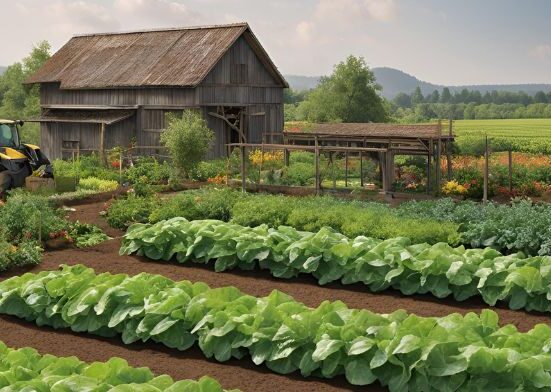Tomatoes are one of the most beloved and widely grown garden vegetables, but growing them successfully requires more than just planting and watering. Without proper support, tomato plants can sprawl, snap under their own weight, or develop diseases due to a lack of air circulation. That’s where tomato cages come in. In this comprehensive guide, we’ll explore everything you need to know about tomato cages—why they’re important, the different types available, how to use them effectively, and tips for choosing the best one for your garden. Whether you’re a beginner or a seasoned gardener, understanding tomato cages is key to cultivating strong, healthy, and productive tomato cage for tomato plants.
Why Tomato Plants Need Support
Tomato plants are vigorous growers that benefit significantly from structural support throughout their growing season. As the plants mature, they produce heavy fruit clusters that can weigh down and even break their branches. Without proper support, the sprawling stems are more prone to bending, snapping, or touching the ground, which invites pests, diseases, and rot. Supporting tomato plants helps maintain good air circulation around the leaves and fruit, thereby reducing the risk of fungal infections, such as blight or mildew.
Additionally, a supported tomato plant is easier to manage and harvest. It keeps the fruit cleaner and more accessible, making routine tasks like pruning, watering, or picking tomatoes far more efficient. Support structures, such as cages, stakes, or trellises, encourage vertical growth, maximizing garden space, especially in smaller plots or container gardens. Support also guides the plant’s growth upward, allowing it to receive more sunlight evenly and promoting better photosynthesis and overall plant health. In summary, providing support for your tomato plants isn’t just about tidiness—it directly influences their productivity, health, and ease of care. Whether you’re growing determinate or indeterminate varieties, a sturdy support system is essential for a successful tomato stakes tomato harvest.
What Is a Tomato Cage?
 A tomato cage is a supportive gardening structure designed to help tomato plants grow upright and stay stable as they develop. Typically made from metal wire or heavy-duty plastic, these cylindrical or square-shaped cages are placed over young tomato plants shortly after they are planted. As the plant grows, the cage offers essential vertical support, preventing the plant from sprawling on the ground. This helps keep the fruit cleaner, reduces the risk of disease from soil contact, and improves air circulation around the plant.
A tomato cage is a supportive gardening structure designed to help tomato plants grow upright and stay stable as they develop. Typically made from metal wire or heavy-duty plastic, these cylindrical or square-shaped cages are placed over young tomato plants shortly after they are planted. As the plant grows, the cage offers essential vertical support, preventing the plant from sprawling on the ground. This helps keep the fruit cleaner, reduces the risk of disease from soil contact, and improves air circulation around the plant.
Tomato cages are especially useful for indeterminate tomato varieties, which continue to grow and produce fruit throughout the season. Available in various sizes and shapes, they provide a simple, reusable, and low-maintenance solution to training tomato vines. By keeping the plants off the ground, tomato cages also make harvesting easier and more efficient. They’re an essential tool for any gardener aiming for healthy, productive tomato heavy-duty tomato cages.
Benefits of Using Tomato Cages
Tomato cages offer essential support for growing healthy, productive tomato plants. These sturdy structures help keep plants upright, preventing sprawling growth that can lead to disease, fruit rot, and pest problems. By encouraging vertical growth, cages improve air circulation and sun exposure, which are vital for ripening fruit and reducing fungal issues like blight. They also make harvesting easier by keeping fruit off the ground and within how to freeze peaches reach.
Using tomato cages reduces the need for frequent tying or staking, saving time and effort throughout the growing season. Cages support the plant’s natural shape, promoting stronger stems and better overall plant health. They are especially beneficial for indeterminate tomato varieties, which grow tall and produce fruit throughout the season. Durable and reusable, metal or wire cages are a cost-effective investment that can last for years. Overall, tomato cages simplify garden maintenance and boost yields by supporting vigorous and organized tomato growth.
Types of Tomato Cages
 Tomato cages come in various styles, each designed to support plant growth and maximize yields. The most common type is the conical cage, a lightweight, tapered wire structure ideal for smaller, determinate tomato varieties. Square or triangular cages offer more stability and are suitable for both determinate and indeterminate plants, often made of sturdy galvanized steel. Heavy-duty tomato cages are taller and stronger, designed to handle large, vining indeterminate tomatoes that grow vigorously. Stackable cages allow vertical extensions as plants grow, providing flexibility throughout the season.
Tomato cages come in various styles, each designed to support plant growth and maximize yields. The most common type is the conical cage, a lightweight, tapered wire structure ideal for smaller, determinate tomato varieties. Square or triangular cages offer more stability and are suitable for both determinate and indeterminate plants, often made of sturdy galvanized steel. Heavy-duty tomato cages are taller and stronger, designed to handle large, vining indeterminate tomatoes that grow vigorously. Stackable cages allow vertical extensions as plants grow, providing flexibility throughout the season.
Foldable or collapsible cages are space-saving and ideal for gardeners with limited storage space. For DIY enthusiasts, homemade cages from concrete reinforcing wire or wooden stakes offer customizable support. Each type has its advantages depending on your garden size, tomato variety, and growing method. Choosing the right cage ensures your tomatoes stay upright, healthy, and productive throughout the growing staking tomatoes season.
Traditional Wire Cages
Traditional wire cages are classic garden supports designed to help plants grow upright and strong. Made from sturdy metal wires, these cages offer reliable support for climbing plants such as tomatoes, peppers, and peas. Their open grid structure allows plants to breathe and receive ample sunlight while keeping stems protected from bending or breaking. Easy to install and reusable, traditional wire cages come in various sizes to accommodate different plant types and growth stages. Durable and weather-resistant, they are a favorite among gardeners for promoting healthier, more productive plants throughout the growing tomatoe cages season.
Heavy-Duty Metal Cages
Heavy-duty metal cages are robust, durable large tomato cages structures designed to provide strong support and protection for plants, animals, or storage needs. Made from high-quality, corrosion-resistant metal, these cages withstand harsh weather conditions and heavy use without bending or breaking. Ideal for garden use, livestock containment, or industrial storage, their sturdy construction ensures long-lasting reliability. Often featuring reinforced joints and a powder-coated finish, they resist rust and wear, maintaining their strength over time. Easy to assemble and maintain, heavy-duty metal cages offer dependable security and support, making them an essential choice for demanding environments and heavy-use large tomato cages applications.
Square or Folding Cages
A Square or Folding Cage is a versatile, space-saving structure commonly used in gardening, farming, or pet care. Designed with a sturdy square frame, it provides reliable support for plants, such as tomatoes, or secure containment for small animals. The folding feature enables easy storage and transport, making it ideal for gardeners with limited space or those who require portable solutions. Made from durable materials such as metal or coated wire, these cages are weather-resistant and long-lasting. Their simple design enables quick setup and breakdown, helping maintain strong plant growth or safe animal housing tomato plant cages efficiently.
DIY Cages (Wood, Bamboo, Concrete Mesh)
DIY cages made from wood, bamboo, or concrete mesh offer versatile and cost-effective solutions for garden and plant support needs. Wooden cages provide sturdy, natural frames that blend seamlessly with outdoor environments and can be easily customized in terms of size and shape. Bamboo cages are lightweight, eco-friendly, and flexible, making them ideal for supporting climbing plants while adding a rustic aesthetic charm.
Concrete mesh cages offer a perfect balance of durability and strength, making them suitable for supporting heavier plants or structures that require robust support. Building your cage using these materials allows for personalized designs tailored to your garden’s unique requirements, promoting healthier plant growth and efficient space best cages for tomato plants management.
Determinate vs. Indeterminate Tomatoes: Choosing the Right Cage
When growing tomatoes, understanding the difference between determinate and indeterminate varieties is crucial for selecting the right cage to support vigorous, healthy plants. Determinate tomatoes, often called “bush” tomatoes, grow to a compact height and produce fruit all at once. They require smaller, sturdy cages that support their limited growth and keep the plant upright during the heavy fruiting period. Indeterminate tomatoes, on the other hand, are vining plants that keep growing and producing fruit throughout the season.
These need taller, more robust cages to accommodate their continuous growth and sprawling vines. Choosing the correct tomato cage not only supports plant health but also improves air circulation and fruit accessibility, reducing disease risk and making harvesting easier. Whether you have a determinate or indeterminate variety, using the right cage tailored to your tomato type is essential for a successful and bountiful subsistence farming harvest.
How to Install a Tomato Cage
Installing a tomato cage is a simple yet effective way to support your tomato plants and promote healthy growth. Start by selecting a sturdy cage that fits the size of your tomato variety. Before planting, place the cage over the spot where you’ll plant the tomato seedling. If the plant is already growing, gently slide the cage around the plant without damaging the stems. Push the cage firmly into the soil, ensuring the legs are deep enough to provide stable support.
As the tomato plant grows, guide its branches through the cage to keep them upright and prevent sprawling. This helps improve air circulation, reduces the risk of disease, and facilitates easier harvesting. For optimal results, check the plant’s position regularly and add ties as needed. Installing a tomato cage is a small step that makes a big difference in producing vigorous, healthy tomato tomato growing cages plants.
Tips for Supporting Healthy Growth
 Supporting healthy growth whether for plants, children, or personal development, requires consistent care and attention to key factors. First, ensure a balanced environment that provides essential nutrients, whether it’s rich soil and adequate sunlight for plants or a nutritious diet and proper sleep for children. Regular monitoring helps detect any early signs of stress or deficiency, allowing timely intervention.
Supporting healthy growth whether for plants, children, or personal development, requires consistent care and attention to key factors. First, ensure a balanced environment that provides essential nutrients, whether it’s rich soil and adequate sunlight for plants or a nutritious diet and proper sleep for children. Regular monitoring helps detect any early signs of stress or deficiency, allowing timely intervention.
Hydration plays a vital role, as water is crucial for cellular functions and overall vitality. Encouraging gradual progress rather than rushing growth promotes stronger, sustainable development. For plants, this might mean proper pruning and pest control; for children, it involves emotional support and learning opportunities. Maintaining a clean and safe space minimizes risks and supports overall well-being. Lastly, patience and consistency are essential—growth takes time, and steady, thoughtful care leads to the healthiest results. Following these tips creates a foundation for flourishing and long-term success in any growth process.
Common Mistakes to Avoid
When tackling any new task or project, avoiding common mistakes can save you time, frustration, and resources. Many people unknowingly fall into similar traps, whether due to a lack of experience, rushing through steps, or overlooking important details. These mistakes often include poor planning, neglecting research, disregarding expert advice, or failing to review work thoroughly. Another frequent error is underestimating the time and effort required, which can lead to missed deadlines and compromised quality.
Additionally, not asking questions when uncertain or skipping essential steps can create bigger problems down the line. By being aware of these pitfalls and approaching tasks methodically, you can enhance efficiency and achieve better outcomes. Learning from others’ errors is invaluable — it helps you build confidence and achieve success more smoothly. This guide highlights the most common mistakes to avoid, helping you navigate challenges and reach your goals What Is an Orchard effectively.
Tomato Cage Alternatives
 Tomato cages are a popular choice for supporting growing tomato plants, but they’re not the only option available. Some gardeners prefer using stakes, which involve driving a sturdy pole into the ground beside each plant and tying the stems to it for vertical support. Others opt for trellises—flat or A-frame structures—that allow plants to climb and spread out, improving air circulation and reducing disease risk.
Tomato cages are a popular choice for supporting growing tomato plants, but they’re not the only option available. Some gardeners prefer using stakes, which involve driving a sturdy pole into the ground beside each plant and tying the stems to it for vertical support. Others opt for trellises—flat or A-frame structures—that allow plants to climb and spread out, improving air circulation and reducing disease risk.
String or wire supports, often referred to as tomato towers or spiral cages, can also be effective in guiding plant growth. For those seeking a DIY approach, homemade supports made from recycled materials, such as bamboo poles or metal rods, work well and can be customized to fit your garden space. These alternatives offer flexibility, affordability, and often easier storage compared to traditional cages, making them excellent choices for gardeners seeking varied support methods for their best tomato cages tomatoes.
Final Thoughts: Strong Cages, Strong Plants
Strong tomato cages are more than just garden accessories—they’re essential tools for nurturing healthy, productive plants. Providing reliable support, sturdy cages prevent sprawling, reduce the risk of disease, and protect delicate stems from damage caused by wind or heavy fruit. When plants grow supported and upright, they receive better air circulation and sunlight exposure, which directly improves fruit quality and yield. Investing in durable cages tailored to your garden’s needs ensures your tomato plants can thrive throughout the growing season.
Whether you choose wire, metal, or reinforced plastic cages, the key is stability and strength to support heavy, vibrant plants. Ultimately, strong cages lead to more vigorous plants, easier maintenance, and a more bountiful harvest. Remember, a well-supported tomato plant is a happy plant, resulting in luscious tomatoes and a rewarding gardening experience. Prioritize support for healthier growth and greater success in your garden!
Conclusion:
Using a tomato cage is one of the simplest yet most effective ways to support your tomato plants and encourage healthy, productive growth. By providing structure and stability, tomato cages prevent plants from sprawling on the ground, reducing the risk of disease, pest damage, and fruit rot. They also make harvesting easier and improve air circulation around the plants, which promotes stronger stems and better overall plant health.
Choosing the right cage—whether wire, plastic, or homemade—and properly installing it early in the growing season can significantly impact your tomato yield. Remember to regularly secure your plants as they grow and prune as needed to maximize airflow and light exposure. With the right support system in place, your tomato plants will thrive, producing robust fruits that bring vibrant color and fresh flavor to your garden and kitchen throughout the entire season. Tomato cages truly are an essential tool for any successful tomato gardener.
FAQ:
What is a Tomato Cage, and Why should I use one?
A tomato cage is a support structure, usually made of metal or plastic, designed to keep tomato plants upright as they grow. Using a cage helps prevent the plant from sprawling on the ground, reduces damage from pests and diseases, and promotes better air circulation and fruit development.
When should I put a Tomato Cage Around my Plants?
It’s best to place the tomato cage around young plants shortly after transplanting them into the garden, before they begin to grow tall. This ensures you don’t damage the roots later by trying to install the cage.
What types of Tomato Cages are Available?
Common types include wire cages, spiral cages, wooden or bamboo stakes with ties, and adjustable or collapsible cages. Wire cages are most popular for their durability and ease of use.
How do I choose the Right size Tomato Cage?
Choose a cage that is tall and wide enough to support the mature size of your tomato variety. For indeterminate (vining) tomatoes, taller cages (4-6 feet) are ideal. Determinate (bushy) varieties need shorter cages.
Can I Reuse Tomato Cages year after year?
Yes! Most metal and sturdy plastic cages can be cleaned and stored for reuse. Be sure to clean off any plant debris and disinfect the cages before storing them to prevent the spread of disease.







